
The Benefits Of Thymosin Alpha-1 In Treating Cystic Fibrosis
Thymosin Alpha-1 and Cystic Fibrosis (CF) are at the forefront of groundbreaking medical research. Recent Ireland studies have shown that
In the field of peptide administration and rehydration, understanding the differences between bacteriostatic water and sterile water is crucial, particularly for research and healthcare professionals. Both substances play a vital role in medical settings, but each has unique properties, advantages, and specific use cases.
Bacteriostatic water, often employed for intravenous injection, is a solution of water and a bacteriostatic agent such as benzyl alcohol, which inhibits the growth of bacteria. This makes it an excellent choice for multiple-dose vials, prolonging the sterility of the solution.
On the other hand, sterile water is devoid of any antimicrobial additives, making it ideal for single-use applications and irrigation. Whether dealing with the parenteral use of sodium chloride, the transport and dilution of other substances, or ensuring the safe usage of intravenous drugs in pediatric patients and other age groups, the choice between bacteriostatic water and sterile water can significantly affect outcomes.
The effectiveness of bacteriostatic water in preventing contamination and the potential for adverse reactions, like the toxicity of other preservatives, sets it apart. For instance, the intravenous administration of bacteriostatic water is typically preferred over saline when a bacteriostatic agent is required to ensure the solution remains free from microbes and other contaminants. However, sterile water is indispensable in scenarios where pure, non-bacteriostatic solutions are necessary, such as in rehydration therapies and certain intravenous injections.
Given the importance of aseptic techniques, the choice of using a sterile syringe, the appropriate dilution to avoid hemolysis of red blood cells, and ensuring the sterility of the substance being administered is paramount. This is particularly vital for vulnerable populations like newborns and pregnant women, where the risks associated with the addition of benzyl alcohol and the toxicity of various other preservatives might be a concern.
In the subsequent sections, we will examine the specific applications, benefits, and drawbacks of both bacteriostatic water and sterile water, providing comprehensive insights for researchers, healthcare professionals, and pharmacists seeking to understand these crucial substances better. Understanding these can illuminate why the right choice of water is fundamental in preventing contamination, managing blood pressure, ensuring the safety and efficacy of drug administration, and promoting overall health in medical interventions.
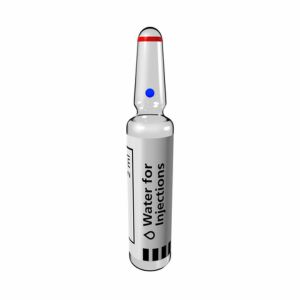
Bacteriostatic Water vs. Sterile Water for Injection: Expert researchers recommend bacteriostatic water as the optimal choice for diluting peptides for subcutaneous injection due to its superior solubility and extended shelf life.
Bacteriostatic water contains 0.9% benzyl alcohol, which acts as a preservative, allowing it to be used multiple times within a 28-day period, unlike sterile water which lacks preservatives and must be used immediately after opening to avoid contamination. Adverse effects are typically minimal, with bacteriostatic water being well-tolerated in most cases.
When experimenting with new peptides, it’s crucial to adhere to best handling practices in your research, including proper storage and aseptic techniques. Bacteriostatic Water vs. Sterile Water: Which will you choose? See table below for a quick comparison of the two waters.
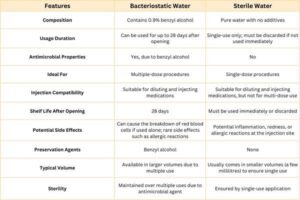
[1] J.Hu, A.Kyad, K.Burke, et al (2023) Critical Aspects of pH Measurement for Bacteriostatic Water for Injection – Journal of Pharmaceutical Sciences, 2023 Aug;112(8):2307-2310.
[2] https://www.sciencedirect.com/topics/ pharmacology-toxicology-and-pharmaceutical-science/ sterile-water

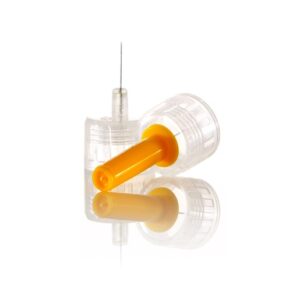

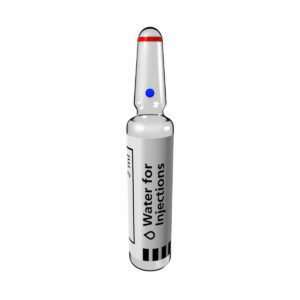
ALL CONTENT AND PRODUCT INFORMATION AVAILABLE ON THIS WEBSITE IS FOR EDUCATIONAL PURPOSES ONLY.
DISCLAIMER: These products are intended solely as a research chemical only. This classification allows for their use only for research development and laboratory studies. The information available on our Ireland Direct Peptides website: https://ireland.direct-peptides.com is provided for educational purposes only. These products are not for human or animal use or consumption in any manner. Handling of these products should be limited to suitably qualified professionals. They are not to be classified as a drug, food, cosmetic, or medicinal product and must not be mislabelled or used as such.

Thymosin Alpha-1 and Cystic Fibrosis (CF) are at the forefront of groundbreaking medical research. Recent Ireland studies have shown that

Exploring the Potential Benefits of Tesofensine Capsules Continued research into the potential benefits of Tesofensine could lead to groundbreaking advancements
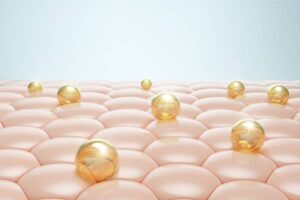
GHK-Cu Capsules: Copper Peptides For Skin In an ever-evolving world of beauty standards, the quest for vibrant, healthy skin remains

Explore the anti-aging effects of Epithalon And Thymalin Stack The pursuit of longevity and delaying the signs of aging is

401 N. Mills Ave, Ste B, Orlando, FL 32803, United States
